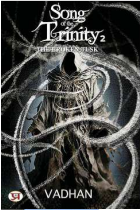The Saga Continues
| Date :29-Jun-2025 |

The Saga Continues :
By RUPALI SETHI :
THERE are some books where, while reading the first few
lines, it becomes crystal clear that it is going to leave a
lasting impact on the readers. Song Of The Trinity - The
Broken Tusk, the second instalment in the Song Of The
Trinity series is one of them by author Vadhan. The prologue starts with an epic battle that everyone has heard of or read
about; the transformative story of Mushika the little mouse found at
Lord Ganesh’s side. Vadhan makes it the beginning of a conflict of
universal proportions, literally. The idea which says that you should
not judge a book by its cover doesn’t apply to this book. The name
reads as The Broken Tusk but the front cover had a hooded cloak
with tentacles around it. The rear cover had an image of a curved
tusk. The hint of the story hidden within the front and rear covers is
clever apart from the brilliant design of the cover.
A hint that is
revealed only after reading the book.
This is a book for the ages, meant to grace a library permanently
because the concepts and philosophies within the book take it
beyond the thriller and fantasy fiction genre into a reiteration of
ancient philosophies on ‘chaos v/s order’ and ‘choice v/s need’. It is
surprisingly refreshing to realise that chaos is not all that bad and
without it, there is no hope. How is that possible? Vadhan fleshes it
out brilliantly be it in dialogue, description or action.
In this story of
good v/s bad, at
some point, readers
will start to wonder
what is good and
bad? Viewed from
a universal lens,
the concepts that
humans hold so
dear are at the
same time carved
out as precious and
innocuous. The
author excels at
world building
while approaching
concepts with a
distinctive outlook.
An example is the
species called
Zri who have the
ability to artificially
extend their lives
but have to sacrifice their leaders to
avoid the resultant
fall out.
There are
nuggets of wisdom
and philosophy
everywhere in the
book with the
characters fleshing
them out brilliantly.
The characters
themselves stand
out distinct from
each other, whether it is the crazily brilliant Rap Sage with his terrible grammar, or Trigund the Anomaly, a villain as much as she is a
victim or the main hero, Aswathaman (Yes, the same one from
Mahabharata but in the present age) and his bafflement over his
curse of amnesic immortality. The other main hero, Shatru, a one-ofa-kind Demi-god, powerful beyond measure but losing his loved
ones in the war against the ancient villain. The author has three
names for the main antagonist: Kroni, Maharishi and ‘The Kali’
which are interspersed expertly depending on the context.
The
beautiful Naga princess, Lalitha, a brilliant strategist and administrator, doomed from the very start and yet her struggle to survive and
even find love tugs at heartstrings or Kris, son of Krishnayani, survivor of a destroyed planet who ends up as Shatru’s apprentice,
timid, shy, with multi-coloured glowing skin and a strong heart.
Indra, King of the Deva, who finally gets his due as a pragmatic,
compassionate and yet seemingly conceited king.
The author has painted on an ambitious and large canvas of universal proportions, extending ancient Indian concepts beyond our
world and into the ‘endless universes’. The book ends but the saga
is set to continue. ■